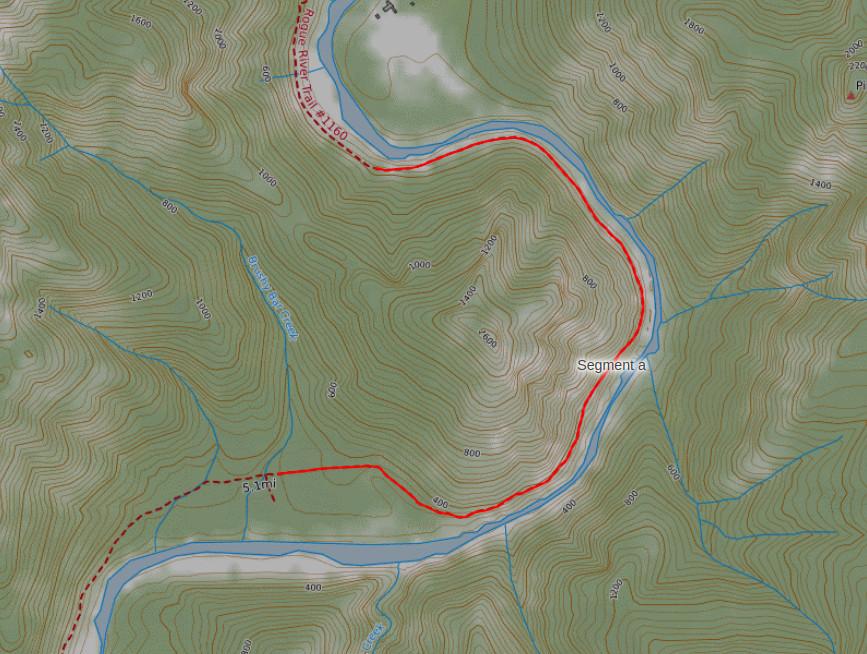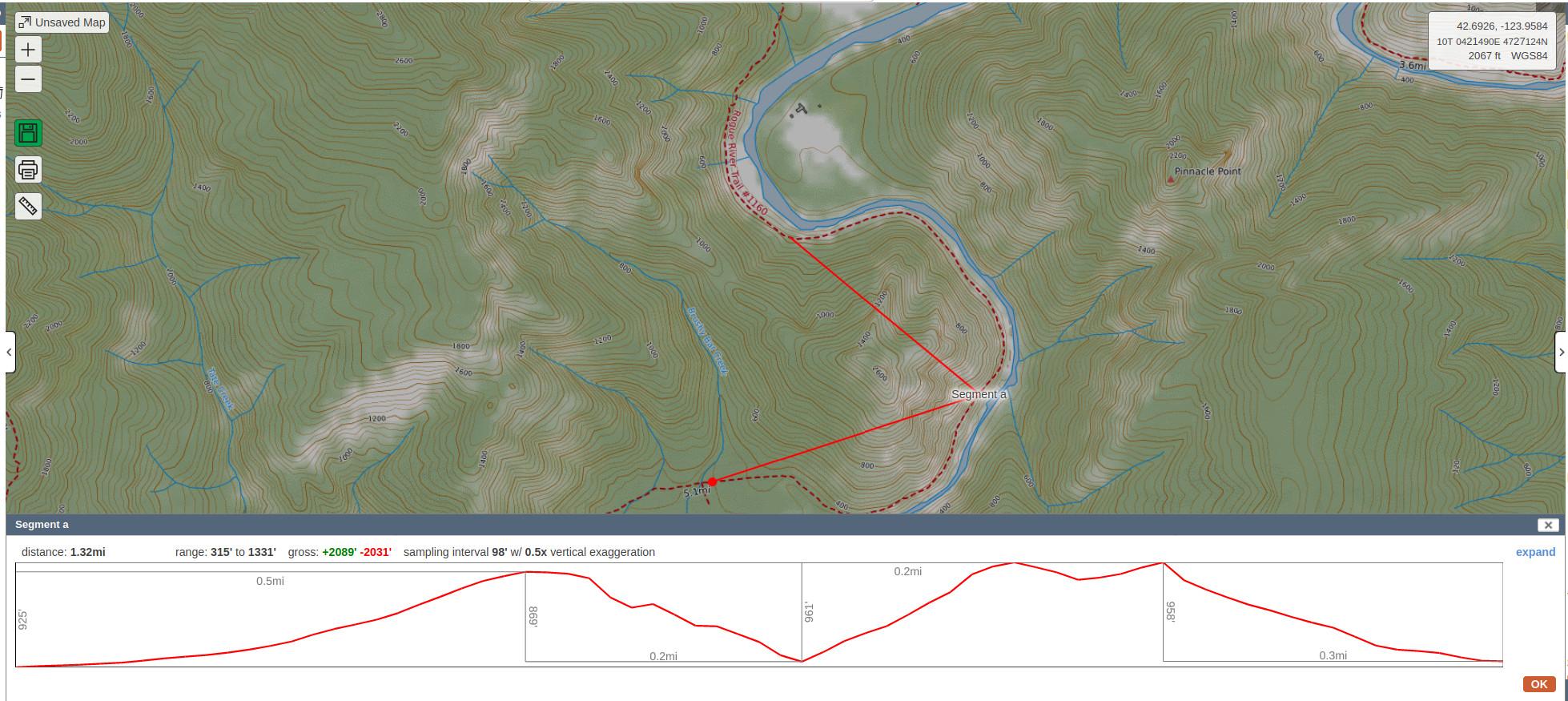Topic
Weird things happening with tracks on Gaia and CalTopo
Forum Posting
A Membership is required to post in the forums. Login or become a member to post in the member forums!
Home › Forums › General Forums › General Lightweight Backpacking Discussion › Weird things happening with tracks on Gaia and CalTopo
- This topic has 8 replies, 6 voices, and was last updated 3 years, 5 months ago by
 Pedestrian.
Pedestrian.
-
AuthorPosts
-
May 23, 2021 at 10:08 am #3713888
I understand that different tools have different sampling intervals and so the data can come out looking different. But I’m finding the weirdness goes beyond that explanation in a recent example. I’m hoping someone might be able to explain it. It doesn’t really matter that much in the case of this particular trip, but I’m wondering if this happens more frequently and I just don’t realize it?
I was planning to hike a version of the Wild Rogue Loop and during trip planning was plotting out the route on CalTopo and Gaia. In the planning phase, they were telling me there was something like 10,000′ elev gain, which was obviously not correct (the route follows the river for a ways, then climbs up to and along a ridgeline that tops out around 3700′, then back to the river).
To settle the mystery, I tracked my actual route using Gaia. Now looking at the track on the computer, CalTopo is saying I climbed over 14,000′ and Gaia claims I did just under 8,000′. I’d love to believe I did either of those, but I doubt I got even Gaia’s reported gain on this short trip; while it was a rolling route it’s hard to believe 8,000′ gain would even be possible. Gaia is also showing I did 3 miles less than CalTopo shows.
In comparing previous routes between Gaia and CalTopo, I usually find the mileage is pretty close and that Gaia underreports elev gain, particularly in rolling terrain. But in this case, the differences are pretty big, Gaia is showing far less gain, and neither elev gain seems close to accurate.
Any idea what’s going on here? Thanks!
May 24, 2021 at 7:10 am #3713933It’s all about sample rate and how things are calculated in between.
Here’s a 1.7 mile segment along the river. I drew the route, and then told Caltopo to resample the route into 1000 points.

And here’s the profile for that route:

Note what Caltopo is saying at the top about the sample interval of 99 feet. So every 99 feet along that line, Caltopo takes a point and grabs the elevation from its elevation database, and uses that to calculate the total elevation gain and loss. Because that trail is like a roller coaster of ups and downs, Caltopo says the overall elevation gain/loss on that 1.7 mile segment is 551/493 respectively. That seems reasonable.Now what happens if we do something really dumb, like reduce the route to just 3 points. I’ve included both the topo map and the elevation profile into one image using Caltopo’s simplified profile.:

Note what Caltopo did here! It still sampled the elevation data every 98 feet along the route! But because the route was super simplified to just 3 data points on the trail with straight lines drawn inbetween, the sample data is pretty bogus. We’re getting elevation data from halfway up that 1600′ peak rather than elevation data that follows the Rogue River! As a result, Caltopo calculated the total elevation, for the same 1.7 miles, as more than 2000 feet up and down, which is 4 times as much elevation gain as the same segment with 1000 points plotted along the actual trail.The lesson here is: your data is only as good as your sample rate, and you need to understand how your tools are sampling.
Here’s a profile of the entire 10 mile segment along the Rogue River using 485 points. It looks like a real roller coaster, so it’s reasonable to expect that the claimed elevation gain/loss is around 2800 feet for just this 10 mile segment, but that estimate is only as good as the datapoints that represent the route followed, and how your tool samples along those data points to give you elevation gain/loss estimates.

It’s the same with distance, too. I teach map and compass to my local outdoors group and lead hikes and trips. People are always comparing notes about what their GPS watch or their Strava or Gaia app says their hiked distance was that day. They wonder out loud why there are differences, and often ask me about it. They don’t understand that all these apps have different sample rates and ways of calculating the distance (and elevation).
May 24, 2021 at 7:12 am #3713934I just realized that the web site has scaled down all my images making it impossible for you to read the text at the top of my elevation profile screen grabs. My apologies. I hope the explanation is clear enough.
May 24, 2021 at 8:07 am #3713935Thanks Jeff. Very helpful explanation.
May 24, 2021 at 8:22 am #3713937I looked at my track of rogue wild trail – from the campground up and then down to Clay Hill – 4395 ascent, 4520 decent – looking at the graph, it’s probably more like 4000, pretty close, but it does have some of the error Jeff described
That’s a nice trail, as is the entire Rogue River trail. I’ve gotten a few ticks, did you see any? Once, I was driving down the freeway back home and noticed one on me. I frantically stopped at an off ramp, took my shirt off, and extracted it
May 24, 2021 at 9:11 pm #3713978Thanks for the explanation, Jeff. I was already aware of the role of sampling intervals and that different apps use different intervals. What surprised and still confuses me in this case is why it’s so wildly incorrect. I use both Gaia and CalTopo for plotting and tracking bike routes around here that I’d say are equally as rolling as this outing was and the results are usually much closer together and within the realm of what’s believable…Pre-trip mapping on CalTopo showed what I thought was a wildly high 11,000′ gain and post-trip track even higher at 14,000′; Gaia was similarly wacky. I’ve never seen anything on either Gaia or CalTopo that was so obviously incorrect…Or am I just so incredibly fit I didn’t notice I was climbing so much? Maybe I’ll just stick with that explanation…
May 24, 2021 at 9:54 pm #3713980When that happens to me I can usually spot sawtooth patterns on the elevation profile. That artificial elevation change can add up.
May 25, 2021 at 6:31 am #3713987Pretty weird. I can’t think of any other plausible explanation!
May 25, 2021 at 9:20 am #3713998This is indeed a head scratcher.
What phone did you use to run these apps while tracking? Model, OS version, app versions?
It would also be interesting to look at the exported gpx files from both apps.
-
AuthorPosts
- You must be logged in to reply to this topic.
Forum Posting
A Membership is required to post in the forums. Login or become a member to post in the member forums!
Our Community Posts are Moderated
Backpacking Light community posts are moderated and here to foster helpful and positive discussions about lightweight backpacking. Please be mindful of our values and boundaries and review our Community Guidelines prior to posting.
Get the Newsletter
Gear Research & Discovery Tools
- Browse our curated Gear Shop
- See the latest Gear Deals and Sales
- Our Recommendations
- Search for Gear on Sale with the Gear Finder
- Used Gear Swap
- Member Gear Reviews and BPL Gear Review Articles
- Browse by Gear Type or Brand.






